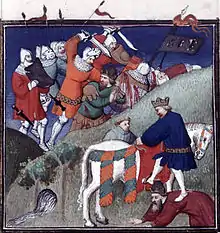Byzantine–Seljuk wars
The Byzantine–Seljuk wars were a series of decisive battles that shifted the balance of power in Asia Minor and Syria from the Byzantine Empire to the Seljuks. Riding from the steppes of Central Asia, the Seljuks replicated tactics practiced by the Huns hundreds of years earlier against a similar Roman opponent but now combining it with new-found Islamic zeal; in many ways, the Seljuk resumed the conquests of the Muslims in the Byzantine–Arab Wars initiated by the Rashidun, Umayyad and Abassid Caliphate in the Levant, North Africa and Asia Minor.
| Byzantine–Seljuk wars | |||||||||
|---|---|---|---|---|---|---|---|---|---|
| Part of decline of the Byzantine Empire | |||||||||
| |||||||||
| Belligerents | |||||||||
| Byzantine EmpireEmpire of TrebizondThe Crusader States | |||||||||
| Strength | |||||||||
| c. 1071:Could raise up to 100,000 troops1140:25,000 to 50,000 field troops | unknown | ||||||||
Today, the Battle of Manzikert is widely seen as the moment when the Byzantines lost the war against the Turks; however the Byzantine military was of questionable quality before 1071 with regular Turkish incursions overrunning the failing theme system. Even after Manzikert, Byzantine rule over Asia Minor did not end immediately, nor were any heavy concessions levied by the Turks on their opponents – it took another 20 years before the Turks were in control of the entire Anatolian peninsula and not for long either.
During the course of the war, the Seljuk Turks and their allies attacked the Fatimid Caliphate of Egypt, capturing Jerusalem and catalyzing the call for the First Crusade. Crusader assistance to the Byzantine Empire was mixed with treachery and looting, although substantial gains were made in the First Crusade. Within a hundred years of Manzikert, the Byzantines had successfully driven back the Turks from the coasts of Asia Minor and extended their influence right down to Palestine and even Egypt. Later, the Byzantines were unable to extract any more assistance, and the Fourth Crusade even led to the sack of Constantinople. Before the conflict petered out, the Seljuks managed to take more territory from the weakened Empire of Nicaea until the Sultanate itself was taken over by the Mongols, leading to the rise of the ghazis and the conclusive Byzantine–Ottoman wars.
Origins

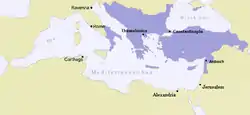
The wars' distant origins lay in the formation of the Byzantine Empire from the collapsing Roman Empire in the 4th century. Prior to the formation of the Byzantine realm in the 3rd century AD, the Roman Empire faced a severe military and political crisis; political assassinations and dangerous campaigning led to 32 Emperors seizing and losing power within 50 years of Roman history.[1] Matters were made worse with an economic and demographic problem. The population of the Roman Empire began to fall in the 4th century due to a lack of conquest leading to a lack of slaves,[2] a vital and significant group of people in the Empire. Reforms by Emperors like Constantine I and Theodosius I prolonged the Roman Empire but nonetheless the Empire split into Eastern and Western Halves in 395 AD.[3] The Western Half (Western Roman Empire) was plagued by barbarian invasions, collapsing in 476 AD whilst the Eastern Half survived and began to undergo Hellenization[4] transforming into what historians label today as the Byzantine Empire. Unlike the Western Half of the Roman Empire, the Eastern Half experienced fewer barbarian invasions although encounters with the Huns and Persians kept the Byzantines busy enough from making any serious recovery attempts in the West.
In the 7th and 8th centuries, the Byzantines experienced several co-ordinated Arab invasions losing several vital provinces, such as Egypt and the Levant. A Byzantine resurgence under the Macedonian Dynasty allowed the Byzantines to reconquer parts of Syria and Mesopotamia; in particular were the efforts of Basil II who from the late 10th century to early 11th century transformed the Empire into the most powerful state in the Medieval World.[5]

Despite this, the Byzantines were far from safe. The decades after the death of Basil II saw a long series of crises and a severe weakening of imperial authority and military power. This included a succession crisis and a series of weak Emperors under the increasing influence of bureaucrats in Constantinople. At the same time the efforts to restrain the ambitious provincial aristocrats kept at bay during Basil II reign failed. With the successes of the previous century, the Byzantine state had acquired more land and wealth. The spoils of war saw the enrichment of the military aristocracy. More and more land owned by free peasants came under the control of this Dynatoi class by varying means from purchase to intimidation to outright robbery. One major consequence of this was the reduction in available manpower to serve in the imperial armies. Added to this were the internal rivalry between the bureaucrats and military aristocracy. Bureaucrats sought to reduce the power and likelihood of the aristocrats to launch rebellions by freeing the yeomanry of military duty in place of providing tax revenue. This further put strain on the manpower needed to defend imperial territory. The factions increasingly relied on mercenaries, but these highly ambitious soldiers were unreliable and lawless.
For the twenty years preceding 1070, in almost every year there saw at least one major rebellion, including a large revolt of Armenians. This caused thematic armies to be drawn west or east depending on the rebellion and opened the borders to incursions by raiders whether the Normans of Sicily or Turkic horsemen from Central Asia or indeed the mercenaries roaming within the state. In addition, a combination of competition, rivalry and treachery between pretenders to the imperial throne saw the state paralysed to deal with the many issues facing the state.
By 1070 during the march on Manzikert, the Byzantine state was in a very precarious position largely of its own making, even on the verge of collapse and failed to secure the Empire against external threats. The biggest threat to the Empire since the Arab invasions were the Turks. The Turks were much like the Byzantines former enemies, the Huns. Combining their excellent riding skills with Islamic zeal, the Turks who converted to Islam in the 7th and later 8th centuries[7] were to become a formidable enemy to a Christian state in decline.
As the Byzantines were making headway against the Arabs in the 10th century, Persia was being ruled by the Ghaznevids, another Turkic people. The migration of Seljuk Turks into Persia in the 10th century led to the Ghaznevids being overthrown. There they settled and adopted Persian language and customs.[8] The Seljuks established a powerful domain and captured Baghdad in 1055 from the Abassid Caliphate. The Abassid Caliphate henceforth became a mere figurehead in the Islamic World. The Seljuk Turks, spurred on by their previous success, now launched an attack on the Levant and against Fatimid Egypt, which lost Jerusalem in 1071.[9]
Encounters between the Seljuk Turks and the Byzantines did not occur until after the reign of Basil II. However, the outcome of another war, the Byzantine-Georgian wars, was in some ways influenced by the incursions of the Seljuk Turks into Georgia,[10] so it is unlikely that they were unheard of.
When the Seljuk Turks did encounter the Byzantines, they had chosen a good time to attack; Byzantium was faced with weak rule, Norman conquests[11] and the schism whilst the Abassid Caliphate had recently been seriously weakened with its wars against the Fatimid dynasty.[12]
Initial Conflicts: 1064–1071
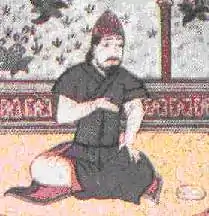
Ever since the early 11th century, the Seljuk Turks from central Asia had been expanding westward,[13] defeating various Arab factions and occupying the Abassid caliphate's power base in Baghdad.[14] At the same time, the Byzantine empire was making a few gains in Edessa and Syria. In 1067 the Seljuk Turks invaded Asia Minor attacking Caesarea and in 1069 Iconium.[15] A Byzantine counterattack in 1069 drove the Seljuk Turks back from these lands.[16] Further offensives by the Byzantine army drove the Turks back across the Euphrates.
Despite this, the Seljuk Turks continued their incursions into Asia Minor, capturing Manzikert. The Byzantine Emperor Romanus Diogenes led an army in an attempt to score a decisive blow against the Seljuks and add some military justification to his rule (which had seen the loss of southern Italy to Norman conquests). During the march, Alp Arslan, the leader of the Seljuk Turks withdrew from Manzikert. His tactical withdrawal allowed his army to ambush the Byzantines, reclaiming Manzikert shortly after.[17] The victory itself led to few gains at the time for the Seljuk Turks, but the civil chaos that resulted in the Byzantine Empire allowed the Seljuks and various other Turkic allies to swarm into Asia Minor.
Turkic Conquests: 1071–1096
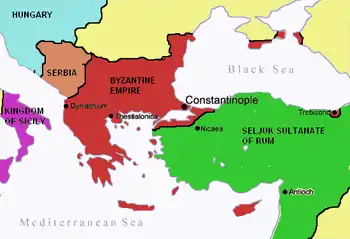
After Manzikert, the Seljuk Turks concentrated on their eastern territorial gains which were threatened by the Fatimid dynasty in Egypt although Alp Arslan encouraged other allied Turks and vassals to establish Beyliks in Asia Minor.[18] Many Byzantines at the time did not see the victory as a total disaster and when the Turks began occupying the countryside in Anatolia they began to garrison the Byzantine cities as well, not as foreign conquerors but as mercenaries requested by various Byzantine factions – one Byzantine Emperor even gave the city of Nicaea's defense to the invading Turks in 1078.[19]
The result of the civil war meant that pretenders to the Byzantine throne sought Turkic aid by conceding Byzantine territory. The loss of these cities such as Nicaea and another defeat in Anatolia led to a prolongation of the war. The civil conflict finally ended when Alexius I Comnenus, who had been leading Imperial armies to defeat revolts in Asia Minor became a rebel himself and seized the Byzantine throne in 1081. Despite emergency reforms implemented by Alexius, Antioch and Smyrna were lost by 1084.[20] However, between 1078 and 1084 the city had been in the hands of Philaretos Brachamios, an Armenian renegade. By 1091, the few remaining Byzantine towns in Asia Minor inherited by Alexius were lost as well. However, all was not to end in defeat for Byzantium; in 1091, a combined Seljuk/Pecheneg invasion and siege of Constantinople was thoroughly defeated whilst the Norman invasions had been held back as well allowing the Empire to focus its energies against the Turks. The Byzantines were thus able to recover the Aegean islands from Tzachas and destroy his fleet, and even regain the southern littoral of the Marmara Sea in 1094.
In 1094, Alexius Comnenus sent a message to Pope Urban II asking for weapons, supplies and skilled troops. At the Council of Clermont in 1095, the Pope preached a Crusade to be undertaken in order to capture Jerusalem and, in the process, assist the Byzantine Empire which could no longer guard Christendom in the East from Islamic aggression.[21] Though the Crusades would assist the Byzantine Empire in reconquering many vital Anatolian towns, it also led to the dissolution of the Empire in 1204 during which time the Byzantines struggled to hold on to their territories.
Byzantium Survives: 1096–1118
The first Crusaders arrived in 1096 following Alexius' appeal to the West.[22] The agreement between the Byzantines and the Crusaders was that any Byzantine cities re-captured from the Turks would be handed over to the Empire.[23]
This was beneficial for the Crusaders as it meant that they did not have to garrison captured towns and lose troop strength whilst maintaining their supply lines. The Byzantines, in return, would supply the Crusaders with food in a hostile territory and Alexius' troops would act as a reserve to reinforce them in any dangerous situations. The Crusaders first set about attacking Nicaea on 6 May 1097.[23] Kilij Arslan I was unable to assist the Turks there due to the immense size of the Crusader armies; another small defeat on 16 May[23] convinced Kilij Arslan to withdraw and abandon the city, which surrendered to the Byzantines on 19 June.[23] After this, a decisive victory at Dorylaeum[24] gave the Crusaders an Asia Minor that was open to attack: Sozopolis, Philomelium, Iconium, Antioch in Pisidia, Heraclea and Caesarea[25][26][27] all fell to the Crusaders and they reached as far as Cilicia where they allied with Cilician Armenia.[28][29]
Unfortunately for Alexius Comnenus, the Byzantines were unable to fully capitalize on these conquests with Caesarea returning to the Seljuks as a part of the Sultanate of Rum along with several other cities such as Iconium, the future capital of the Seljuk Turks. However, in a campaign in 1097 John Doukas, the megas doux (Alexios' brother-in-law), led both land and sea forces which re-established firm Byzantine control of the Aegean coastline and many inland districts of western Anatolia, taking the cities of Smyrna, Ephesus, Sardis, Philadelphia, Laodicea and Choma from the demoralised Turks.[30]

Following their victories, the Crusaders went on to lay siege to Antioch a city under Seljuk occupation. The siege marked the end of Crusader assistance to the Byzantines due to the simulations of Stephen of Blois. Kerbogha the Seljuk governor of Mosul, had a huge army of 75,000 troops sent to relieve Antioch; his unsuccessful siege of Edessa (a city that had recently fallen to the Crusaders) allowed the Crusaders time to capture Antioch on 3 June 1098,[31] a day before Kerbogah's arrival. Despite this, Kerbogah's troops were able to breach the citadel[31] where vicious and desperate fighting allowed the Crusaders to repulse his offensive. At this point, one of the Crusaders present, Stephen of Blois deserted and reaching Alexius Comnenus warned him that the Crusaders were destroyed and the Byzantine Emperor was forced to turn back.
As a result of this apparent desertion of Alexius I, the Crusaders refused to hand back Antioch when they managed to defeat Kerbogah's scattered army.[32] With this resentment, the Crusaders largely abandoned assisting the Byzantines against the Seljuks and their allies. A further Crusade in 1101 to follow up the successes of the First ended in total defeat[33] and the consolidation of Seljuk power in Asia Minor with Iconium (modern day Konya) being established as the capital of the Sultanate of Rum.
Byzantine counter-attack: 1118–1176
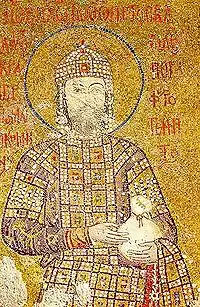
John II Comnenus
The death of Alexius I brought John II Comnenus to power. By now, the Seljuk Turks had fractured and became loosely allied to each other.[34] During this time the Sultanate of Rum was busy fighting off their former allies, the Danishmends. John Comnenus was able to use this to his advantage as he undertook a series of campaigns in Anatolia and Syria. John successfully captured the southern coast of Anatolia as far as Antioch, defeated an attempt by the Gabras family to form a breakaway state in Trebizond, and recaptured the ancestral home of the Comnenus family at Kastamonu. Despite this, Turkish resistance was strong and John did not capture the Seljuk capital at Konya, nor were all of his conquests held – the city of Gangra, captured by John in the 1130s, was lost again as the emperor had left it with a garrison of just 2,000 men.
John spent considerable time and effort on a series of campaigns in Syria, which emphasised his dominance over the local Crusader kingdoms, especially Edessa and Antioch, but resulted in no long-term territorial gains for the Byzantine Empire. The emperor did strengthen the Byzantine army by recruiting new divisions and establishing new castles, fortifications and training camps in Byzantine territory. However, the scale of resources poured into his campaigns in Syria was far greater than in Anatolia, suggesting that John viewed prestige as more important than long-term conquest. In 1143, a fatal hunting accident to the emperor John robbed the Byzantines of the opportunity to achieve further progress.[35]
Manuel Comnenus
John II died in 1143, leaving the Byzantine Empire a strong army, significant reserves of cash, and improved prestige. However, the new emperor, Manuel Comnenus, directed much of his attention to Hungary, Italy, Serbia and the Crusader states rather than Anatolia. While Manuel was largely successful in defeating attacks on the empire and holding the Balkans, his policy in Italy was a failure and the lavish expenditure of his rule has been criticised, most notably by the Byzantine historian Choniates. During this period, the Seljuk Turks were able to subdue their enemies, the Danishmends under Kilij Arslan II.[36] This resulted in a powerful centralised Turkish state based at Konya, leaving the Byzantines arguably in a worse position than they had been under John II.
For the time being, Manuel's policy was not without merit as the emperor established peaceful co-existence with the Sultan and initiated measures such as allowing Turkmen to pay for pasture on Byzantine land, which were clearly meant to deter raiding. The establishment of the theme of Neokastra on the northern part of the Aegean coast near Pergamon was also praised by Choniates. However, when Kilij Arslan refused to hand over the city of Sivas, which he was bound to do under an earlier agreement with Manuel, the emperor declared war in 1176 and led a very large army estimated at around 30,000 men into Seljuk territory with the intent of taking its capital Iconium. However, the Byzantine force was ambushed in a mountain pass with consequent heavy losses to both sides. This battle, the Battle of Myriokephalon, resulted in the Byzantine campaign of conquest being abandoned.[37]

The battle was tactically indecisive with both leaders keen to seek peace. Following this Manuel's army continued to skirmish with the Turks in Anatolia, defeating them in a smaller but indecisive battle in the Meander Valley. Regardless of this small respite, Myriokephalon had far more decisive implications than the casualties would suggest – there was no more Byzantine reconquest in Asia Minor after 1176, leaving the process begun by Alexios incomplete at best. For the Seljuks, the acquisition of Danishmend territory gave them a victory though once again the Seljuks had to contend with neighbouring disputes leading to the peace treaty as requested by both leaders. By the terms of the treaty, Manuel was obliged to remove the armies and fortifications posted at Dorylaeum and Sublaeum.
However, Manuel Comnenus refused and when Kilij Arslan tried to enforce this treaty, a Turkish army invaded Byzantine territory and sacked a string of Byzantine cities as far as the Aegean coast, damaging the heartland of Byzantine control in the region. Nevertheless, John Vatatzes, who was sent by the Emperor to repel the Turkish invasion scored an ambush victory over the Turks at the Battle of Hyelion and Leimocheir in the Meander valley. The Turkish commander and many of his troops were killed while attempting to flee, and much of the plunder was recovered, an event that has been seen by historians as a sign that the Byzantine army remained strong and that the defensive program of western Asia Minor was still successful.[38] After the victory on the Meander, Manuel himself advanced with a small army to drive the Turks from Panasium and Lacerium, south of Cotyaeum.[39] However, in 1178 a Byzantine army retreated after encountering a Turkish force at Charax, allowing the Turks to capture many livestock.[40] The city of Claudiopolis in Bithynia was besieged by the Turks in 1179, forcing Manuel to lead a small cavalry force to save the city and then, even as late as 1180, the Byzantines succeeded in scoring a victory over the Turks.[40]
However, the continuous warfare did have a serious effect upon Manuel's vitality; he declined in health and in 1180 succumbed to a slow fever. Furthermore, like Manzikert, the balance between the two powers began to gradually shift – Manuel never again attacked the Turks and, after his death, they began to move further and further west, deeper into Byzantine territory.
Seljuk Empire collapse 1194–1260
In 1194, Togrul of the Seljuk empire was defeated by Takash, the Shah of Khwarezmid Empire, and the Seljuk Empire finally collapsed. Of the former Seljuk Empire, only the Sultanate of Rûm in Anatolia remained.
As the dynasty declined in the middle of the thirteenth century, the Mongols invaded Anatolia in the 1260s and divided it into smaller principalities called the Anatolian beyliks.
Analysis
Byzantine army
As the below table demonstrates, the population of Byzantium did not fall as a result of Seljuk acquisitions; manpower was still as readily available in 1143 as in 1025. In fact, Western Asia Minor and Greece experienced a population growth on an unprecedented scale, thanks in part due to the trade of the Italian city states of Venice and Genoa and also due to the influx of Greek refugees fleeing the Seljuk Turks.[41] Manuel Komnenos' first expedition to Iconium saw the entire Greek population of Philomelion evacuated and settled west. However, the efficiency and resources needed to raise large armies had dwindled somewhat, as can be seen by John and Manuel's failure to create a national army.
| Year | Population | Soldiers | Area |
|---|---|---|---|
| 1025 | 12,000,000 | 110,000 | Byzantine Empire |
| 1143 | 10,000,000 | 50,000 | Byzantine Empire |
| 1204 | 9,000,000 | 30,000+ | Byzantine Empire |
| 1281 | 5,000,000 | 20,000 | Byzantine Empire[42] |
Throughout the 10th and 11th centuries, the Byzantine Army was utilized in an increasingly aggressive manner, with new conquests made in the East and the West.[43] As a result, the Theme system which was designed as a defensive military solution to wear down invasions of Asia Minor slowly began to break down. Troops were needed that would maintain a full-time presence on the field, something that the Thematic militia armies drawn from peasant farmers could not do. As a result, the use of Tagmata, full-time professional soldiers became increasingly necessary to wage the offensive warfare that had propelled Byzantium to Great Power status in the 11th century.[44] The Tagmata were also drawn from mercenaries, such as Franks, Normans and no doubt Saxons, Rus' and Vikings. The use of Tagmata troops did not directly undermine Byzantine military strength – Romanus Diogenes' campaigns into Seljuk controlled Mesopotamia was composed of Tagmata as well as Theme troops. Nonetheless, the Theme troops began to seriously decline in quality.[45] Michael Attaleiates commented at the time of the Manzikert Campaign that the troops of the Theme system were poorly supplied, poorly provisioned and unfit for warfare. Consequently, when the Tagmata army was routed at Manzikert, the Theme system could not stop the relentless advance of the Seljuk Turks and their Turkic allies as they swarmed over Asia Minor, over-running the last Byzantine settlements in 1091. The Tagmata army was not the cause of the failure at Manzikert; however, the reliance on the Tagmata troops was one of the causes that led to the disintegration of the Theme System. As the Turks took Asia Minor, any organized resistance (as demonstrated by Alexius I's pre-Imperial career) had to make-do with an army in a poor condition.
Furthermore, the frontline had moved much closer to Constantinople. Throughout the 12th century, Constantinople held the initiative against Iconium, especially so under Manuel's early and middle rule, thanks in part due to his aggressive policies and that of his Father, but when the balance of power shifted to the Turks, losses steadily mounted; soon Western Asia Minor became infiltrated by Turkish ghazis.
Crusades
Historians continue to debate the effect of the Crusaders on Byzantium. The First Crusade saw Byzantium make substantial gains in territory although this may have been achieved by the Byzantines themselves; there were plenty of civil conflicts in Asia Minor and amongst the Turks for Alexius to exploit. Furthermore, every other Crusade after the First had a detrimental effect on the Empire with Crusader armies unable to resist raiding towns which were supposed to be their allies[46] but in Byzantine territory there were quarrels over supplies and a few incidents of fighting. Once again, the westerners had created an unfavorable impression of themselves, and once again the Greeks had made themselves seem untrustworthy. At Constantinople, there were further incidents, even to the point that Conrad III threatened to return from the crusade and take the city by force. The Second Crusade saw increased unity amongst the Islamic World,[47] with Zengids able to bring Damascus into the fold and soon after much of Syria became a united front against the Crusades and a threat to Byzantine interests there. The Holy Roman Emperor Frederick I even threatened an assault on Constantinople in the Third Crusade and the Fourth Crusade saw the sack of Constantinople and substantial loss of territory by the Byzantines to the Frankish Crusaders and the Seljuk Turks.
Long term consequences of the Crusade also includes increased Islamic fanaticism and no more clearly is this seen then in the numerous Beyliks set up in Western Anatolia after 1204, particularly the Beylik of the Ottomans, Osman I's domain.[48] Later, the Crusades of Nicopolis in 1396 and Varna in 1444 designed to aid the Byzantines made Constantinople appear as a magnet for Frankish Knights to launch their zealous attacks – this did not help the Byzantines in the long run.
On the other hand, the Crusades allowed Byzantium a chance to regain power in the Mediterranean. Additionally, under Manuel Comnenus, the Byzantine and Catholic Churches experienced far better relations than in the previous few decades and even coming close to healing the Schism. The alliance with the Pope was also crucial. Together, the Byzantines and Catholics were able to put on hold the incursions of the Normans from southern Italy who were ravaging Byzantine territory in the Balkans, becoming almost as dangerous a threat as the Seljuk Turks.
Seljuk Turks
The war's outcome was determined as much by the weakness of the Byzantines as the strengths of the Seljuks. Nonetheless, the latter, just like the Arabs many years earlier, failed to destroy the Byzantine Empire. The Seljuk Turks, having originated from the steppes, possessed many advantages. At the Battle of Manzikert, the Byzantine heavy cavalry was defeated using simple hit and run tactics,[51] with the faster light cavalry of the Turks outflanking and outmaneuvering the exhausted cavalry.
Asia Minor was not completely overrun by the Turks after Manzikert but the resulting chaos that followed was easily exploited – Turkic soldiers had been used as Mamluks by the Arabs before seizing power themselves – the same occurred in Asia Minor, with Byzantine factions inviting Turkic mercenaries to garrison towns. As Imperial rule was re-imposed in Byzantium, these factions, which were secured by Turkic soldiers, became part of the Seljuk Turk domains. Some Greeks fled conquered areas, others stayed to become second-class citizens in an Islamic world (though under Islamic rule were protected provided they paid the jizya tax). More importantly, others converted and were assimilated into the settling population of Turks. Orthodox churches were replaced with Mosques and the crippling Imperial taxes levied by the government and the accompanying Church were lowered.
Conclusion
Though Anatolia had been under Roman rule for almost 1000 years, the Seljuks rapidly consolidated their holdings.[52] This allowed them to hold on to their lands and made it all the more difficult for the Byzantines during the Komnenian restoration to re-conquer. The result was that even when the Byzantine empire was not riddled with civil disputes, it could not defeat the Seljuk Turks, who rarely allowed the Byzantines to engage them, hence the slow campaigning of John Komnenus.
The old Roman state was in a constant state of war due to the numerous enemies on its borders; Muslims to the South and East, Slavs to the North and Franks to the West. The Byzantine Empire had to face Normans, Pechenegs and Turks within a few decades of each other at a time when the army was torn in civil conflict.
Consequences

The war had great consequences. The Middle East had been dominated for centuries by the power of the Fatimid Caliphate and the Byzantine Empire; by the end of the 13th century, neither of the two were in a position to project power; the Fatimids having been toppled by the Kurdish influenced Ayyubids, whilst the Byzantines severely weakened by the Seljuks. Power shifted to the Mamelukes by the 14th century and then back to the Turks in the late 15th and early 16th centuries. Never again would a Christian Kingdom wield so much military and political power in the Middle East. As the Turks steadily gained ground in Anatolia, the local population converted to Islam, further reducing any chances of a successful reconquest.[53]
The War also gave Western Christendom the opportunity to launch expeditions/pilgrimages to visit/liberate the Holy Land from Muslim Rule. In time, these Crusaders would establish their own fiefs in the Holy Land, ruling with interests coinciding, but more often in conflict with, the Byzantine Empire, ultimately leading to a weakening of both the Crusader states and the Byzantine Empire.
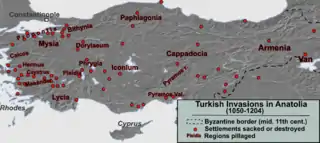
For the Turks, it was the beginning of a new era of power. Despite further invasions and attacks by Crusaders from the west and the Mongols and Turkic tribes from the east, the Turks slowly emerged as a superpower under the Ottomans.[54] The rise of the Ottomans was parallel to the fall of the Sultanate of Rum and the carving up of the Byzantine Empire. The power vacuum left in Anatolia was easily exploited by one of the Sultanate's nobles, Osman I. Matters were made worse for the Byzantine Empire due to the Latin presence in the Peloponnese and the rising power of the Bulgarians who continued to press hard against the borders of Byzantium. In time, the Byzantines would be forced to call on the aid of the Ottomans to head to the European mainland and fight the Bulgarians, giving the Ottoman Turks a firm grip on Europe. The close proximity of Osman's Beylik ensured that confrontation between the Byzantines and the Ottomans would be inevitable. The Byzantines were a match for the Ottomans but events west of Constantinople coupled with civil war and incompetent leadership left the Byzantines reeling from one siege after another until Constantinople fell in 1453.
See also
References
- "Table of the Emperors". About.com. 2007. Retrieved 3 November 2007.
- "Book Review: Deep in denial (or in de' Mississippi)". Asia Times Online. 7 September 2005. Retrieved 3 November 2007.
- "Theodosius I". The Columbia Electronic Encyclopedia (6th ed.). Columbia University Press. 2007. Retrieved 3 November 2007.
- "Heraclius". Answers.com. Retrieved 3 November 2007.
- Holmes, Catherine (1 April 2003). "Basil II (A.D. 976–1025)". De Imperatoribus Romanis. Retrieved 3 November 2007.
- Black, Jeremy (2005). The Atlas of World History. American Edition, New York: Covent Garden Books. pp. 65, 228. ISBN 978-0-7566-1861-2. This map varies from other maps which are slightly different in scope, especially along the Mediterranean and the Black Sea.
- "Seljuk Empire". Tiscali encyclopedia. Research Machines. 2007. Archived from the original on 30 May 2008. Retrieved 3 November 2007.
- Amir-Moezzi, M.A. "Shahrbanu". Encyclopaedia Iranica. Archived from the original on 15 October 2007. Retrieved 3 November 2007.
... here one might bear in mind that non-Persian dynasties such as the Ghaznevids, Saljuqs and Ilkhanids were rapidly to adopt the Persian language and have their origins traced back to the ancient kings of Persia rather than to Turkish heroes or Muslim saints ...
- bint 'abd al-Karim al-hakim al-Fassi, Anahita (20 November 2000). "Know Your Turks!". Retrieved 3 November 2007.
- "Georgia in the De veloped Feudal Period (XI–XIII cen.)". About Georgia. Archived from the original on 2 December 2010. Retrieved 4 February 2010.
- Bicheno, Hugh. "Robert Guiscard". Answers.com. Retrieved 3 November 2007.
- "The Abassid dynasty". Archived from the original on 12 October 2007. Retrieved 3 November 2007.
- "The Seljuk Empire". All Empires. Archived from the original on 12 March 2012. Retrieved 3 November 2007.
- Bright, Martin (16 March 2003). "Iraq's 5,000 years of pride". The Guardian Unlimited. Retrieved 3 November 2007.
- Sherrard 1966, p. 164.
- http://navsci.berkeley.edu/ma20/PPT/14%20Feb%2006%20Byzantine.ppt Archived 26 June 2007 at the Wayback Machine.
- Rickard, J. "Battle of Manzikert, 19 August 1071". Retrieved 3 November 2007.
- "Before of the Crusades – 350 – 1095 – Timeline of the Crusade: Christianity vs. Islam:". About.com Agnosticism/Atheism.
- Markham, Paul. "The Battle of Manzikert: Military Disaster or Political Failure?". Archived from the original on 13 May 2007. Retrieved 19 May 2007.
- "Antioch – Britannica Concise Encyclopedia". britannica.com. Retrieved 14 April 2018.
- Urban II. "Speech at Clermont 1095". Medieval Sourcebook. Retrieved 3 November 2007.
- Madden 2005, p. 35.
- Madden 2005, p. 40.
- Rickard, J. (3 April 2001), Battle of Dorylaeum, 1 July 1097.
- Madden 2005, p. 41.
- Mango 2002, pp. 185–187.
- Parker 2005, pp. 48–49.
- Chahin 2001, p. 244.
- Phillips 2014, p. 28.
- Angold, Michael (1984). The Byzantine Empire 1025–1204. Longman, Harlow Essex. p.150
- Madden 2005, pp. 42–43.
- Rickard, J. (2 April 2001), Antioch, Kerboga's siege of, 5–28 June 1098
- Knox, Skip E. "Second Battle of Ramleh Archived 13 June 2010 at the Wayback Machine." The Crusades. Boise State University. 2 June 2007.
- "The Seljuk Empire – All Empires". Archived from the original on 12 March 2012. Retrieved 28 May 2007.
- Stone, Andrew. "An Online Encyclopedia of Roman Emperors." 26 November 2004. University of Western Australia. 2 June 2007
- Houtsma, Martin Theodoor (1911). . In Chisholm, Hugh (ed.). Encyclopædia Britannica. 24 (11th ed.). Cambridge University Press. p. 608–611.
- "Events After Myriokephalon." GeoCities. 2 June 2007.
- Birkenmeier, J. W. (2002). The Development of the Komnenian Army: 1081–1180. History of warfare. 5. Boston: Brill. p. 196. ISBN 90-04-11710-5.
- Treadgold, W. (1997). A History of the Byzantine State and Society. Stanford: Stanford University Press. p. 649. ISBN 0-8047-2421-0.
- Stone, A. "Manuel I Comnenus".
- Whilst some stayed, large numbers of Turk farmers settled in Cappadocia, thus undermining the decaying Thema system
- "World Gazetteer, Greece". Archived from the original on 1 October 2007. Retrieved 30 January 2007.
- Haldon 2002, p. 48.
- Haldon 2002, p. 49.
- Haldon 2002, p. 51.
- Knox, Skip (19 June 2007). "Second Crusade". Crusades. Boise State University. Archived from the original on 1 December 2010. Retrieved 19 June 2007.
- Bentley & Ziegler 2006, p. 533.
- Turnbull, Stephen. The Ottoman Empire 1326–1699. New York: Osprey, 2003. p. 17
- "" Des Cas des nobles hommes et femmes ", de " JEHAN BOCCACE ", traduction de " LAURENT DE PREMIERFAIT "". Gallica.
- http://www.allempires.com/empires/seljuk/seljuk_warriors_enh.jpg
- Grant, R G. (2005). Battle. A Visual Journey Through 5000 Years of Combat. London: Dorling Kindersley.
- "Turkey Sultanate of Rum." www.workmall.com. Jan. 1995. The Library of Congress Studies. 29 May 2007
- Bentley & Ziegler 2006, p. 465.
- Tom Brosnahan. "Seljuk Turks".
Further reading
- Bentley, Jerry H.; Ziegler, Herbert (2006). Traditions & Encounters a Global Perspective on the Past (3rd ed.). Boston: McGraw–Hill. ISBN 0-07-295754-9.
- Cahen, Claude (1968). Pre-Ottoman Turkey: A General Survey of the Material and Spiritual Culture and History c.1071-1330. New York: Taplinger.
- Chahin, Mark (2001). The Kingdom of Armenia. London: Routledge. ISBN 0-7007-1452-9.
- Cheynet, Jean-Claude (1998). "La résistance aux Turcs en Asie Mineure entre Mantzikert et la Première Croisade". ΕΥΨΥΧΙΑ. Mélanges offerts à Hélène Ahrweiler (in French). Paris: Éditions de la Sorbonne. pp. 131–147. ISBN 9782859448301.
- Grant, R. G. (2005). Battle a Visual Journey Through 5000 Years of Combat. London: Dorling Kindersley. ISBN 1-4053-1100-2.
- Haldon, John (2002). Byzantium at War: AD 600–1453. Oxford: Osprey. ISBN 1-84176-360-8.
- Madden, Thomas F. (2005). Crusades the Illustrated History (1st ed.). Ann Arbor: University of Michigan Press. ISBN 0-472-03127-9.
- Mango, Cyril (2002). The Oxford History of Byzantium (1st ed.). New York: Oxford University Press. ISBN 0-19-814098-3.
- Parker, Geoffrey (2005). Compact History of the World (4th ed.). London: Collins. ISBN 0-00-721411-1.
- Phillips, Jonathan (2014). The Crusades, 1095-1204. New York: Routledge. ISBN 978-0-415-73636-7.
- Sherrard, Philip (1966). "Great Ages of Man Byzantium". New York: Time-Life Books. Cite journal requires
|journal=(help) - Vryonis, Speros (1971). The Decline of Medieval Hellenism in Asia Minor and the Process of Islamization from the Eleventh through the Fifteenth Century. Berkeley: University of California.
